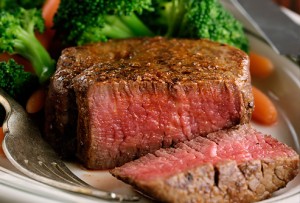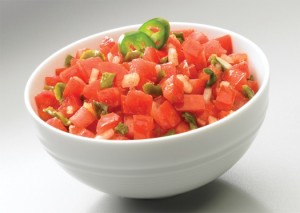The 21 day exercise and meal plan program includes the 72 hour contest prep diet also known as the 3 day Quick Fix. The details are included in the kit.


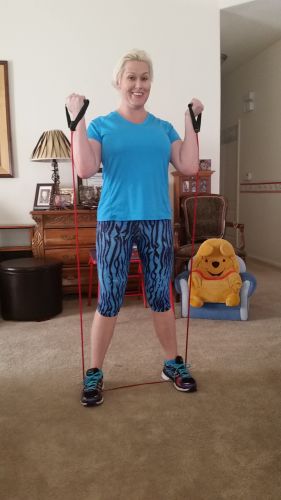
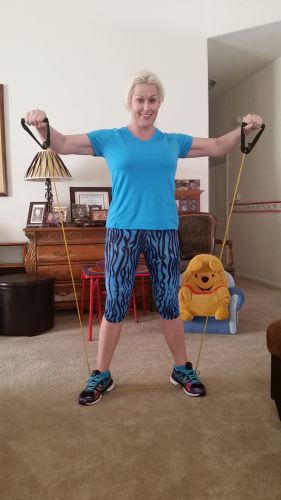
September 8, 2015
March 26, 2012
The Leanest Cut of All
Is it possible to eat beef on a regular basis and not get beefy in the process? Absolutely, says an article that appeared in a supplement to the October 2005 issue of Tufts University Health & Nutrition Letter. The trick is to select the right cut of beef and to exercise portion control.
Here’s a look at 10 of the leanest cuts, which, according to the National Cattleman’s Beef Association, contain on average only 1 more gram (g) of saturated fat than a skinless chicken breast per 3-ounce serving:
1. eye round (1.4 g saturated fat, 4 g total fat)
2. top round steak (1.6 g saturated fat, 4.6 g total fat)
3. chuck mock tender steak (1.6 g saturated fat, 4.7 g total fat)
4. bottom round (1.7 g saturated fat, 4.9 g total fat)
5. top sirloin (1.9 g saturated fat, 4.9 g total fat)
6. round tip (1.8 g saturated fat, 5.0 g total fat)
7. 95% lean ground beef (2.4 g saturated fat, 5.0 g total fat)
8. brisket (flat half) (1.9 g saturated fat, 5.1 g total fat)
9. shank crosscuts (1.9 g saturated fat, 5.4 g total fat)
10. chuck shoulder roast (1.8 g saturated fat, 5.7 g total fat)
—
original article from IDEA Fitness
March 23, 2012
Low-Fat Beats Low-Carb For Heart Health
For people at risk for hypertension, reducing fat intake may be key to protecting the heart. According to a study published in the American Heart Association’s journal Hypertension, a low-fat diet is more effective than a low-carbohydrate diet in reducing the risk of developing hypertension, a precursor to cardiovascular problems such as atherosclerosis.
When the two types of diets were compared in apparently healthy participants, the low-fat diet was the winner at improving blood pressure markers, such as blood flow in the arteries. This led the researchers to conclude that low-fat diets “may confer greater cardiovascular protection” than low-carb diets.
—
source: IDEA Fitness
March 22, 2012
Hot Salsa Tip
Did you know that salsa has surpassed ketchup as America’s favorite condiment? Salsa can spice up all kinds of bland meals. Stir in a jar of your favorite salsa to add some zing to a pot of kidney, white, pinto, red or black beans; then top with a dollop of sour cream for a unique, high-fiber side dish.
March 21, 2012
How to Stop Yourself Eating from Boredom
 People who struggle with their weight are often prone to “emotional eating”, consuming food as a response to mental triggers rather than physical hunger. Often, dieters fail to lose weight not because their diet plan itself is flawed, but because they are knocked off course by feeling stressed, tired, upset or bored.
People who struggle with their weight are often prone to “emotional eating”, consuming food as a response to mental triggers rather than physical hunger. Often, dieters fail to lose weight not because their diet plan itself is flawed, but because they are knocked off course by feeling stressed, tired, upset or bored.
The last of these is an especially common cue for many people to eat. For some, it’s a habit learned in childhood (“I’m bored, mum!” – “Run down to the shop and buy yourself a candy bar, then.”) For others, it’s a reaction to the dull parts of adult life: munching on biscuits while rocking the baby to sleep, or getting yet another handful of chocolates because the afternoon is really dragging at work.
Avoid Snacking When You’re Bored
When you find yourself thinking, “I’m bored, maybe I’ll have a cookie,” then get straight out of that mindset:
- If you’re genuinely hungry, have some fruit or a small sandwich.
- Cravings can be beaten, just by sitting them out. Force yourself to wait 20 minutes before getting that snack, and nine times out of ten, you’ll no longer want it.
- Find something to do – ideally, an activity that makes it hard to eat at the same time.
Understanding Your Danger Points
Keep a food diary for a couple of weeks, and write down not only what you ate and when, but why you ate. (Hunger, because friends were eating, because it was lunch-time, boredom, stress..?)
When are you most likely to eat from boredom? Maybe it’s when you have to hang around at home, waiting for a delivery. Or perhaps it’s when you get in from work and you’re waiting for your partner to come home. Once you’ve figured out the pattern, work out how to change it!
- Find a hobby or interest to occupy you, if you’ve got too much time on your hands
- Use those “hanging around” moments, to blitz through all the little jobs you keep putting off (cleaning the oven, anyone?)
- If you’re regularly twiddling your thumbs at work, see if there’s a stressed colleague who could use your help.
What are your tips for avoiding boredom-induced snacking?
—
Article courtesy of: diet-blog
Image courtesy from: Tony Jalicea
March 19, 2012
6 Fitness Tips to Follow While Traveling
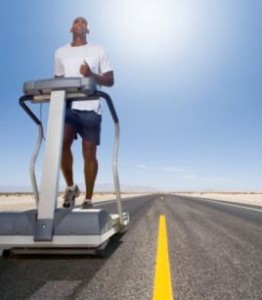 If on the whole you make the effort to eat healthy and have an effective exercise regime, you are likely to be concerned that any travel plans will derail this process. So here are some tips that will help you continue with your fitness programs even when you travel.
If on the whole you make the effort to eat healthy and have an effective exercise regime, you are likely to be concerned that any travel plans will derail this process. So here are some tips that will help you continue with your fitness programs even when you travel.
1. Do some homework before you leave. Check if the hotel that you plan to stay in has gym facilities or a pool and so on (depending upon your preferred workout activity).
2. Remember to pack workout clothes and shoes. This will remind you to work out and also make it convenient to hit the gym or simply head out for a walk wherever you are staying.
Workout shoes can be bulky so rather than carrying them in your baggage, you can simply wear them when you travel and instead pack the other less bulky shoes into your bag.
3. Carry a jump rope or a couple of dumbbells or kettle bells with you. A session with the jump rope can be a really strenuous workout in a short time, and doing a few weights with dumbbells or even lifting some bottles of bottled water can be a good workout.
4. Do other exercises that don’t need equipment – pushups, leg raises, squats, lunges and stair climbing are all easy to do wherever you are.
5. When eating out, order items that are steamed, grilled or poached. Avoid the items that are fried or calorie rich – if it says ‘crispy’ or ‘golden’, it’s probably been deep-fried, if it says ‘rich gravy or dressing’ that means high in calories too.
Also remember if it is a salad you’re ordering, ask for vinaigrette dressing rather than a cream or mayo-based one. Order small portions and opt for fruit instead of a confection at the end of the meal
—
Courtesy from FitnessHealthZone
March 17, 2012
Ready to Rock Your Body for the Summer Heat?
June 2, 2011
The myth of ripped muscles and calorie burns
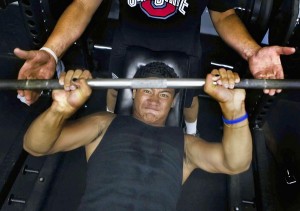
Weight training can build muscle, but that doesn't mean you start burning calories like a Hummer burns gasoline. (Mark Boster, Los Angeles Times / May 16, 2011)
Sorry to say, but gaining muscle doesn’t make your metabolism skyrocket. Put down that Haagen-Dazs.
Whenever I hear about some amazing way to boost resting metabolism, my male-bovine-droppings detector goes berserk. Take the perennially popular one stating that 1 pound of muscle burns an extra 50 calories a day while at rest — so if you gain 10 pounds of muscle, your resting metabolic rate (RMR) soars by an extra 500 calories each day.
Awesome!
And also drivel. I’m more likely to believe bears use Porta-Potties and the pope is a Wiccan.
Though its origins are uncertain, any number of fitness magazines have made the “50 calories per pound of muscle” statement. Popular weight-loss gurus have jumped on the muscle-building-as-panacea-for-fat-loss bandwagon as well.
Dr. Mehmet Oz said in a 2007 presentation to the National Cosmetology Assn., “Muscle burns about 50 times more calories than fat does.” Bill Phillips wrote in his bestselling “Body for Life” that, “through resistance training, you can also significantly increase your metabolic rate … weight training is even superior to aerobic exercise for people who want to lose weight.” And Jorge Cruise wrote in “8 Minutes in the Morning” that his exercise regimen “will help you firm up five pounds of lean muscle within the first few weeks, allowing your body to burn an extra 250 calories per day.”
Gain 5 pounds of muscle in the first few weeks? If only.
Let’s use me as an example. I’ve added about 20 pounds of muscle through several years of hard weightlifting. If this myth holds true, I’ve gained 1,000 calories of additional resting metabolic rate each day. Well, I keep pretty close tabs on my energy balance, and I can guarantee this isn’t happening. Too bad, because those extra 1,000 calories a day could translate to a gluttonous feast of salt-and-vinegar potato chips and cookie dough ice cream.
Beyond making me the go-to guy for opening pickle jars, what other contributions are made by that extra muscle? To get the answer, I spoke with Claude Bouchard of the Pennington Biomedical Research Center in Baton Rouge, La., who has authored several books and hundreds of scientific papers on the subject of obesity and metabolism. Bouchard told me that muscle, it turns out, makes a fairly small contribution to RMR.
“Brain function makes up close to 20% of RMR,” he said. “Next is the heart, which is beating all the time and accounts for another 15-20%. The liver, which also functions at rest, contributes another 15-20%. Then you have the kidneys and lungs and other tissues, so what remains is muscle, contributing only 20-25% of total resting metabolism.”
So, if you slave at weightlifting and increase your muscle mass by an ambitious 20%, this translates into only a 4% to 5% increase in RMR. Since a 200-pound man has an RMR of roughly 2,000 calories, a 20% increase in muscle mass equals only an 80- to 100-calorie increase.
For fun, let’s run the numbers in even more detail, adding the role played by body fat. Bouchard sent me a follow-up email explaining that — based on the biochemical and metabolic literature — a pound of muscle burns six calories a day at rest and a pound of fat burns about two calories a day, contrary to what the myth states. So, muscle is three times more metabolically active at rest than fat, not 50 times.
Again, let’s use me as a guinea pig and do the math. The 20 pounds of muscle I’ve gained through years of hard work equate to an added 120 calories to my RMR. Not insignificant, but substantially less than 1,000. However, I also engaged in a lot of aerobic activity and dietary restriction to lose 50 pounds of fat, which means I also lost 100 calories per day of RMR. So, post-physical transformation, my net caloric burn is only 20 calories higher per day, earning me one-third of an Oreo cookie. Bummer.
Don’t think I’m down on weights; I lift four hours a week because it’s awesome. It makes me stronger, increases my bone density and improves the strength of my connective tissues. It hardens me against injury from other activities. And my wife says that it makes me pretty from the neck down.
Bill Phillips told me through an assistant that weightlifting is better for fat loss because “each new pound of muscle tissue increases chronic total energy expenditure/metabolism” and that “aerobic exercise alone does not offer this benefit.” However, a sizable body of research shows that intense aerobic activity like running burns twice as many calories per hour as hard weightlifting, and the metabolic boost from added muscle is not nearly enough to compensate for this difference.
(I should note that Phillips and I are on the same general side in that we both recommend a combination of aerobic training and weightlifting.)
But wait! When you factor in “after burn,” couldn’t weightlifting still be some miracle calorie-consumer? Sorry, Conan, but after-burn — technically called excess post-exercise oxygen consumption, or EPOC — does exist, but only to a small degree. As I’ve covered in an earlier column, the EPOC of interval training is insignificant. And the same holds true for weightlifting.
A quick scan of the research:
• In 1995, researchers at the University of Limburg in the Netherlands published a study in Medicine & Science in Sport & Exercise on 21 male subjects and determined that weight-training “has no effect” on RMR.
• In 1994, researchers at the Royal Veterinary and Agricultural University in Denmark compared 10 bodybuilders with 10 lean (you are so puny!) subjects. Published in the American Journal of Clinical Nutrition, the report found that intense weight-lifting did not result in any measurable EPOC.
• In 1992, researchers from the University of Texas at Austin compared intense weightlifting with intense aerobic exercise on 47 males and reported in the American Journal of Clinical Nutrition that “RMR did not significantly change after either training regimen.”
Certainly the act of weightlifting burns calories, but intensity makes a big difference. In 1988, researchers at the University of Alabama in Birmingham published a study in the Journal of Applied Sport Science Research that used 17 subjects to compare the caloric burn of light versus heavier weightlifting.
When accounting for the same total volume of weight lifted (lifting 100 pounds three times is the same “volume” as lifting 300 pounds once), they found that when people lifted at 80% intensity, they burned three times as much energy as lifting at 20% intensity.
All of this, in any case, ignores the most important part of weight loss: what you eat. “The bottom line is that weight loss is 90% about diet,” obesity researcher Dr. Sue Pedersen, a specialist in endocrinology and metabolism in Calgary, told me. “The studies show that exercise alone is not going to result in weight loss.”
In other words, hours of running and weightlifting won’t burn your belly fat if you fuel that exercise with Haagen-Dazs.
May 31, 2011
Are Americans Too Big To Drive Small?
Karen Steelman, a stay-at-home mom from Athens, Ga., has tried to like small cars. She read plenty of reviews, kicked their tires, and has even taken a few test drives.
But none of them make her feel safe. And none of them make her feel comfortable.
Steelman has a body mass index of about 37 – seven points above the obesity mark. She’s among a growing number of Americans who feel they are too big to comfortably drive a small car.
“I want to be environmentally friendly, but unless I am in an SUV these days … I find no pleasure or comfort in driving,” she says.
Automakers have long tried to figure out how to get Americans to buy smaller cars. But with obesity rates climbing, at least one analyst says there’s little point in trying.
Growing waistlines simply prevent a lot of U.S. drivers from feeling comfortable or secure in smaller cars. So, unless the entire country goes on a diet, says Dan Cheng, vice president and partner at business consulting firm AT Kearney, we may be destined to keep driving big cars no matter how much a gallon of gas costs in the future.
Cheng says the number of light trucks – a segment of the car market that includes SUVs, minivans, and pickup trucks – has increased steadily since the 1970s. And so has the percentage of adults in the U.S. who are classified as obese.
The number of obese people in the U.S. is expected to increase from 40% this year to about 43% in 2018, Cheng says. Cheng predicts that will keep almost half the population from even considering a small car except for purely economic reasons as small cars tend also to be cheaper than big cars or SUVs.
Calculating the “real” obesity rate in the U.S. is a little tricky. Cheng’s 40% rate is at the high end of estimates. The Center for Disease Control says the overall self-reported obesity rate in the U.S. is 26.7%, with nine states reporting obesity rates over 30%. In any case, the rate is nowhere close to the 15% rate the CDC considers to be a healthy obesity rate.
Small cars have made up 22.6% of the U.S. car market so far this year. Back in 2008, small car sales made up about 28% of the market, back when gas spiked over $4 a gallon.
Smaller cars and alternative fuels are critical to President Obama’s plan to reduce the nation’s dependence on foreign oil. The President last week promised to cut oil imports by a third by 2025. To do that, the country will have to slash its petroleum use.
First Lady Michelle Obama has made fighting childhood obesity one of her public service missions, but so far no one in the Obama Administration has made the connection.
Virtually All Cars and SUVs are Becoming Much More Fuel Efficient
Today’s SUVs and mid-sized sedans and crossovers are becoming more fuel efficient than their predecessors of a decade ago. But it’s smaller cars, which tend to be the most fuel efficient of all because they are smaller and lighter, that are critical to automakers meeting toughening fuel economy standards imposed by Congress.
Automakers have to meet a Congressionally mandated fleet average of 35 mpg by 2016.
Some of the most fuel-efficient small vehicles on the road get over 40 mpg, like the Ford Fiesta. The most fuel-efficient pickup truck is the Ford Ranger, and it gets 24 mpg, according to the government site fueleconomy.gov. A new Kia Rio, debuting this fall, will also be above 40 mpg when certified by the EPA. But neither of these vehicles was especially designed to accommodate widening waistlines.
Ironically, there are a few small cars that are designed to be extra roomy inside making them noteworthy for their interior spaciousness, if not for exceptional fuel economy. The Honda Fit, Nissan Cube and Versa, and Scion xBall have ample space up front, with good headroom and comfortable space for the driver. The Volkswagen Beetlehas long been a favorite among large people because of its easy egress and excess headroom.
Of those cars, only the Fit and Versa get above 30 mpg, and only just barely. In order for automakers to reach a 35 mpg fleet average by 2016, automakers need to boost those ratings closer to 40 mpg.
The most fuel efficient compact SUVs — the Hybrid versions Ford Escape, Mercury Mariner and Mazda Tribute — get 32 mpg. Their non-hybrid versions get 25 mpg.
Resources For the Future, a Washington D.C. think-tank that explores environmental and energy issues, says they’ve found a link between obesity and large vehicle sales, too. They say policies that reduce obesity can also reduce fuel consumption, because smaller people drive smaller cars.
Automakers like Ford are trying to design interiors that keep the bigger population comfortable. Elizabeth Baron, Ford’s technical specialist for virtual reality and advanced visualization, says the automaker has recently updated its database of model human sizes to incorporate the growing number of obese adults.
Automakers Looking at Console and Roofline To Make More Room
To keep drivers comfortable, her team focuses on a few key areas: The center console, seat controls on the left, and head room. If the center console is too large, it can press into peoples’ bodies. And the storage space in the console can be awkward for larger people to use. Seat controls can also be difficult to reach. Also, because obese drivers sit higher in their seats, they often feel squeezed if the roof line is too low. Automakers also need to be aware of where they place sunroof controls, because those can get in the way.
Robert Dean Cole, from Kenosha, Wis., is 6 foot 7 inches and 240 pounds, and his six-year-old son is nearly 5 feet tall.
“Obviously, little cars are not going to be in our future,” he says.
While he’d like to own a car with better gas mileage, he says he can barely fit behind the steering wheel in most of them.
“And even if I could actually fit under the steering wheel of the car my next worry would be surviving a car accident,” he says. “Good chance I won’t be surviving due to my size.”
So he recently purchased a Ford F-150 – one of the biggest vehicles in the U.S. It is also the most popular.
Jake Fisher, senior engineer at Consumer Reports, thinks it’s more that fear of being crushed that keeps most people away from small cars. Fisher has recently been test-driving a Fiat 500 for Consumer Reports, and he can fit his entire family in the car comfortably. They’ve enjoyed using it for around town.
But out on the highway, when they encounter some trucks, being in the small can feel a bit sketchy, he says. “When you drive up next to a Suburban, it’s a little intimidating,” Fisher says.
Consumer Reports, in fact, last year came out with a list of “Best Cars for Larger Drivers,” to spotlight their recommendation to auto companies to redesign seats and seat-belts for reasons of both comfort and safety. The consumer advocacy organization, which tests cars, recommended several cars for their roomy driver position and easy access. AOL Autos Editors augmented that list with a few selections and can be seen in the gallery below.
Still, because SUVs have been so popular for so long, many consumers won’t consider small cars out of fear they will come up on the short end of a one-on-one collision with one. Also, auto designers say many drivers, especially women, have come to like the elevated, commanding seating positions that come with SUVs. This attitude is especially prevalent in rural markets where pickups and SUVs make up a larger percentage of overall vehicles than in the cities and suburbs.
But the idea that bigger is safer is often not true. Many small cars get as good or better crash ratings than larger vehicles because automakers have engineered many safety features into small cars precisely to make up for their lack of mass in a collision with a larger vehicle. The 2011 Ford Fiesta has a 4-star crash rating from the Federal government, as listed at www.safecar.gov, the same as the Ford F-150 pickup truck, and better than some larger corossovers and SUVs like the Toyota RAV4 (which gets 3-Star). The Scion TC, built by Toyota and a small car, earned a 5-star rating.
It’s important to research each car under consideration for purchase because size of vehicle doesn’t always tell the whole safety story. But the vehicle does need to fit in the first place when a customer sits behind the wheel.
Bottom Line
A vehicle needs to fit its occupant, and clever design and engineering can overcome size limitations. As any large person who has test driven cars can attest, the Honda Fit and VW Beetle are roomier for the driver than some larger vehicles like Ford Taurus or Nissan Maxima.
Automakers under pressure to achieve better fuel economy across their lineup may need to give greater consideration to making small cars more comfortable for average Americans. Those that place sleek design over practical will lose customers and consideration.
February 26, 2011
Many stick with fast food after heart attack: study
 It would seem logical for patients who have had a heart attack to cut back on fast food.
It would seem logical for patients who have had a heart attack to cut back on fast food.
Some devoted fast food eaters do. But six months later, more than half can still be found at their favorite fast food places at least once a week, according to a study in the American Journal of Cardiology.
Of nearly 2,500 heart attack patients studied by John Spertus, at the University of Missouri at Kansas City, 884 — or 36 percent — reported in a survey while still hospitalized that they had eaten fast food frequently in the month before their heart attack. “Frequently” was defined as once a week or more.
When Spertus and his colleagues checked back six months later, 503 were still eating fast food every week.
“Fast food consumption by patients with AMI (acute myocardial infarction) decreased 6 months after the index hospitalization, but certain populations — including younger patients, men, those currently working, and less educated patients — were more likely to consume fast food, at least weekly, during follow-up,” he wrote.
“Novel interventions that go beyond traditional dietary counseling may be needed to address continued fast food consumption after AMI in these patients.”
But the study showed that older patients and those who had bypass surgery were more likely to be avoiding fast food six months later.
The survey did not ask what menu items people ordered, and some in the restaurant business have pointed out that fast food isn’t always limited just to burgers and fries.
But Spertus and his colleagues pointed out that the people in their study who kept eating fast food tended to have health profiles “consistent with selection of less healthy options.”
Nine out of 10 patients in the study received dietary counseling before they left the hospital, but this didn’t seem to affect that odds that frequent fast food eaters would improve their diets, and Spertus said this showed they needed more education after leaving the hospital.
“The problem is that patients are absorbing so much information at the time of their heart attack, that I just don’t think they can capture and retain all the information they’re getting,” he told Reuters Health.
Fast food restaurants in the United States will soon post calorie, fat, sodium and other nutritional information on their menus, as required by the health care law passed last year.
Already, cities such as New York and Philadelphia mandate calorie counts on menus.
—
Source: http://bit.ly/eAnRdI
Image Courtesy from: Marketingpower.com
